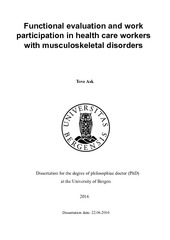| dc.contributor.author | Ask, Tove | en_US |
| dc.date.accessioned | 2016-07-01T10:25:52Z | |
| dc.date.available | 2016-07-01T10:25:52Z | |
| dc.date.issued | 2016-06-22 | |
| dc.identifier.isbn | 978-82-308-3296-7 | en_US |
| dc.identifier.uri | https://hdl.handle.net/1956/12228 | |
| dc.description.abstract | Background: In Norway and other western countries, musculoskeletal disorders (MSDs) are the most frequent reasons for sick leave and disability pensions, and particularly employees in the health and social sector have a high sick leave level. Purpose: The main purpose of the project was to gain more knowledge regarding the functional level of employees with MSDs, whether on sick leave (less than 4 months’ full sick leave) or in work despite having pain, and to gain experience with a functional evaluation tool. In addition, we aimed to have close cooperation with the workplace to increase our understanding of employers’ perspectives and experiences in preventing or reducing sickness absence. Methods: Health care workers were recruited from the Department of Health- and Social Service in the municipality of Bergen from January 2012 to December 2014. Data from the functional evaluation were compared between those on full sick leave, partial sick leave and those staying in work, and factors associated with being on sick leave were examined (Study I). Participants with low back pain that met the inclusion criteria were invited to a randomised controlled trial (RCT) (not part of our study). All who were not included in the RCT, received advice and a report and verbal feedback from the functional evaluation tool, and four weeks later they were asked to return a short questionnaire about the usefulness of the brief functional evaluation (Study II). Focus group interviews were also conducted: three focus groups with employees (11 participants), and five with their supervisors (26 participants). Through the interviews we explored the employees’ and supervisors’ experiences with the brief functional evaluation (Study II), and we also explored the supervisors’ strategies when following up employees with MSDs (Study III). Results: A total of 250 employees (92.4 % women) underwent a functional evaluation. We found that participants on full sick leave had statistically significant poorer physical function compared to those working and to those on partial sick leave. Logistic regression showed that a reduced level for the physical dimension of the Short-Form 12 Health Survey (SF-12) and a high lift test were significantly related to full sick leave (OR 0.86, p < 0.001) (OR 0.79, p = 0.002). The physical dimension of SF-12 was the only variable that was associated to partial sick leave (OR 0.91, p = 0.005). Of the 194 employees who received a written evaluation report, three- quarters completed the questionnaire, and about 70% found the evaluation useful. Three main themes relating to its usefulness emerged from the qualitative data analyses: 1) Clarification and raising awareness, 2) The functional evaluation report as a tool for communication, and 3) Increased knowledge - altered behavior. In Study III, the supervisors described different strategies related to three phases in sick leave management and five corresponding themes: Phase 1) Promoting well-being and a healthy working environment, Phase 2) Providing early support and adjustments, and Phase 3) Making employees more responsible, using confrontational strategies in relation to employees on long-term sick leave, and cooperation with general practitioners (GPs). Conclusions: Reduced physical function can be measured in an early phase of sickness absence in employees with MSDs. Health care workers on full sick leave due to MSDs, who underwent a functional evaluation, had lower (worse) scores on selfreported and directly measured physical function compared to a working group with MSD and those on partial sick leave. Both employees and supervisors found the brief functional evaluation useful for clarifying the employees’ functional level and for obtaining advice to improve employees’ health and work functioning. At the workplace, the supervisors applied strategies to support as well as make demands on, and confront the employees. Moreover, the supervisors requested a closer cooperation with the GPs, which they believed could facilitate a faster return to work. | en_US |
| dc.language.iso | eng | eng |
| dc.publisher | The University of Bergen | eng |
| dc.relation.haspart | Paper I: Ask T, Skouen JS, Assmus J, Kvåle A. Self-reported and tested function in health care workers with musculoskeletal disorders on full, partial or not on sick leave. Journal of Occupational Rehabilitation, 2015; 25:506-17. The article is available in BORA at: <a href="http://hdl.handle.net/1956/9643" target="blank">http://hdl.handle.net/1956/9643</a> | en_US |
| dc.relation.haspart | Paper II: Ask T, Magnussen LH, Skouen JS, Skaar A, Kvåle A. Experiences with a brief functional evaluation for employees with musculoskeletal disorders as perceived by the employees and their supervisors. European Journal of Physiotherapy, 2015; 17:166–175. This article is not available in BORA. The published version is available at: <a href="http://dx.doi.org/10.3109/21679169.2015.1061594"target="blank"> 10.3109/21679169.2015.1061594</a> | en_US |
| dc.relation.haspart | Paper III: Ask T, Magnussen LH. Supervisors’ strategies to facilitate work functioning among employees with musculoskeletal complaints. A focus group study. The Scientific World Journal,2015;2015:865628. The article is available in BORA at: <a href="http://hdl.handle.net/1956/11702" target="blank">http://hdl.handle.net/1956/11702</a> | en_US |
| dc.title | Functional evaluation and work participation in health care workers with musculoskeletal disorders | en_US |
| dc.type | Doctoral thesis | |
| dc.rights.holder | Copyright the author. All rights reserved. | |
| dc.identifier.cristin | 1372325 | |
